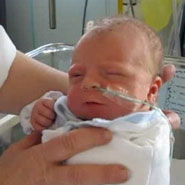Back in October I wrote about how animal research has enabled the development of brain cooling as a treatment to reduce brain damage in babies who had suffered oxygen starvation during birth. This is a problem that affects tens of thousands of babies every year, and frequently results in death or long-term disability. Brain cooling is already beginning to have an impact in the clinic, but a recent report on the BBC website shows how scientists are already improving on it by adding the inhalation of the gas xenon to the therapy . The first clinical trial on a baby born at St Michael’s Hospital in Bristol was a success and more trials are now planned, an achievement that rests on a decade of research in rats and pigs.

Xenon is a rare gas which is best known for its use in street lamps, but it has also recently been approved as an anaesthetic and lacks many of the side effects associated with more commonly used anaesthetics such as nitrous oxide . A decade ago researchers at Imperial College London (ICL) became interested in the potential of xenon to protect the nervous system after in vitro studies showed that it blocks a cell surface receptor – the NMDA receptor – whose activation can lead to the death of nerve cells. It was however not clear if xenon would have neuroprotective effects in vivo, since many other molecules that antagonize the NMDA receptor also have neurotoxic effects that cancel out the benefits of blocking it.
To resolve this question the ICL scientists studied whether the neurotoxic effects of injecting a chemical that binds and activates the NMDA receptor on the brains of rats could be blocked by inhalation of xenon. Their results demonstrated that xenon had a far better neuroprotective effect than other NMDA receptor blockers such as nitrous oxide and ketamine (1), and prompted several other scientists to begin animal studies evaluating whether xenon could be used to prevent brain damage after oxygen starvation.
One of those scientists is Professor Marianne Thoresen , whose work on brain cooling I discussed earlier. Her team at the University of Bristol performed a series of studies of the effect of combining hypothermia with xenon treatment in a newborn rat model of ischemia followed by hypoxia that recreates the effects of oxygen starvation in human babies (2,3). They observed that not only did the addition of xenon therapy double the effectiveness of hypothermia in preventing brain injury, but also that these benefits were still clear when rats had reached adulthood. This was studied through analysis of brain tissues and by using tests that examined the rats ability to manipulate food pellets in a puzzle were used to measure fine motor dexterity. The combination of the two therapies were found to be additive, Xenon therapy without cooling was far less effective, especially in the long term.
This was not the end of Bristol team’s work, Xenon is a rare and expensive gas and xenon therapy in newborn humans would require treatment for several hours. Designing a respirator that could deliver xenon with minimal waste was a key goal for the group if this therapy was to enter widespread use in hospitals. Led by Dr. John Dingley they designed a closed-circuit xenon delivery system which optimises gas delivery so that the patient receives a sufficient dose while minimizing xenon consumption, and demonstrated that it worked safely and efficiently for 16 hours in a newborn pig model of ischemia and hypoxia (4). With solid evidence from studies in rats for the benefits of combining cooling and xenon therapy, and the development of an effective delivery system for Xenon in pigs, the Bristol team were ready to begin human trials.
By coincidence the National Geographic Channel aired a program last night entitled Genius Hog which examined the contribution that pigs make to medical research – a brilliant beast indeed!
Paul Browne
1) Ma D. et al. “Neuroprotective and neurotoxic properties of the `inert’ gas, xenon” British Journal of Anaesthesia Volume 89(5), Pages 739-746 (2002) PubMed: 12170064
2) Dingley J et al. “Xenon provides short-term neuroprotection in neonatal rats when administered after hypoxia–ischemia. “ Stroke Volume 37, Pages 501–506 (2006) DOI:10.1161/01.STR.0000198867.31134.ac
3) Thoresen M et al. “Cooling combined with immediate or delayed xenon inhalation provides equivalent long-term neuroprotection after neonatal hypoxia-ischemia” J Cereb Blood Flow Metab. Volume 29(4), Pages 707-714 (2009) DOI: 10.1038/jcbfm.2008.163
4) Chakkarapani E. Et al. “A closed-circuit neonatal xenon delivery system: a technical and practical neuroprotection feasibility study in newborn pigs.” Anesth Analg. Volume 109(2), Pages 451-460 (2009) DOI: 10.1213/ane.0b013e3181aa9550
